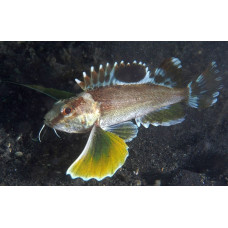Latin name
Apistus carinatus
Other name
Bearded waspfish, longfin waspfish or ringtailed cardinalfish.
Identification
Body elongated, compressed at the sides, covered with scales. It differs from all genera of the family by the shape of its swim bladder - there is a band that divides the bladder into 2 parts - anterior, almost square, with a notch in the anterior part, and posterior, having an ovoid shape. The interorbital space is 10 times smaller than the length of the skull base. Chin with antennae.
Features of fish fins
The lower ray of the pectoral fin is separated from the fin, and the fin itself is greatly elongated. Dorsal spines (total): 14-16; Dorsal soft rays (total): 8-10; Anal spines: 3-4; Anal soft rays: 6-8.
Fish colouring
Body coloration is bluish gray on the back and sides, but darker on the back. Abdomen white, dorsal fin gray with an elongated bright black spot between 9 and 12-13 barb rays. Second dorsal fin with 4-5 rows of dark brown spots. Pectoral fin blackish with white upper edge. Pelvic fins are yellowish. Anal fin - grayish with longitudinal dark brown stripes. Caudal fin is gray with 3-8 rows of dark vertical stripes.
Distribution
Widespread in the waters of the western Pacific and Indian Oceans eastward to South Africa and the Red Sea.
Habitat
Deep-water marine benthic species. Occurs at depths of 15 to 60 m, rarely to 200m. Prefers sandy and silty bottoms.
Size
Length up to 20 cm. Lengths of 10 cm are common.
Behavior
During the day, they burrow deep into the sand, leaving only their eyes open. When disturbed, they spread their long, brightly colored pectoral fins to scare away predators. They use their fins to capture prey, and sensitive antennae under their mouths allow them to detect those that have burrowed into the substrate.
Food and feeding habits
Feeds mainly on crustaceans, to a lesser extent on fish.
Reproduction
The reproduction of this species is poorly understood.
Fishing
Not of particular interest to fisheries, but caught in the Persian Gulf in trawl nests, sometimes in seine nets, and in Australia as bycatch in shrimp fisheries.
Relationship with a person
Have poisonous spines on their fins. Sold in markets in small quantities fresh or dried and salted.
| Classification | |
| Phylum | Chordata |
| Class | Actinopterygii |
| Squad | Scorpaeniformes |
| Family | Scorpaenidae |
| Genus | Apistus |
| Species | A. carinatus |
| Features | |
| Conservation status | Least Concern |
| Habitat | Pelagic |
| Life span, years | No information |
| Maximum body weight, kg | No information |
| Maximum length, cm | 20 |
| Sailing speed, m/s | No information |
| Threat to people | Not edible |
| Way of eating | Predator |
Ocellated waspfish
Tags: ocellated waspfish

